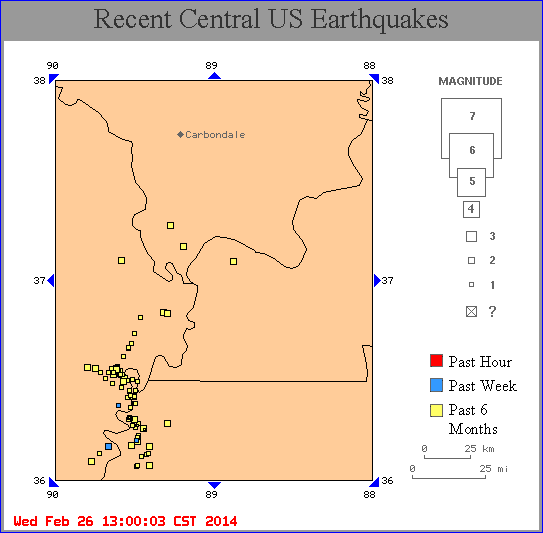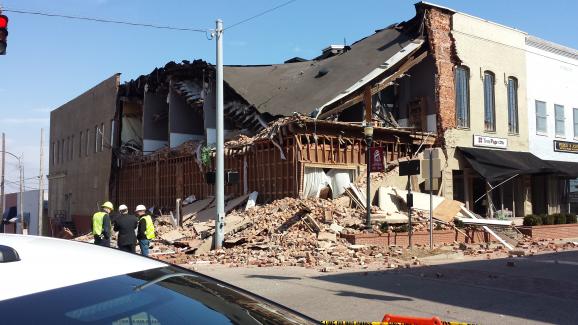Mary Potter, West Kentucky Journal
Wednesday, February 26, 2014 4:34 pm
|
The building collapse in Murray over the weekend was the latest in a series of falling structures in Western Kentucky. Over the past several years, every town in the Purchase has experienced a building collapse.
Mayfield underwent unanticipated urban renewal when buildings on the court square suddenly collapsed. The square now boasts a large bank on one corner and a new drugstore on the other.
Fulton experienced building collapses in its downtown a few years ago. The space once occupied by a brick and mortar building is now a small park
In 2010, a brick and mortar building collapsed in Hickman’s downtown.
In early 2013, the Hickman County Historical & Genealogical Society building collapsed in the middle of the night.
In Paducah, a roof collapsed onto the third floor of a downtown building.
Bardwell’s downtown was decimated after fire swept through tornado damaged buildings.
The former movie theater in Hickman Kentucky fell and blocked downtown streets in July 2010.
Bowling Green made international news when a sinkhole suddenly ate several classic Corvettes.
Buildings collapse in all seasons. Buildings collapse at all times of the day. Most with little warning.
All of the buildings that fell were bricks and mortar. All of the buildings were old - not European old - but American old, late nineteenth century, early 20th century old.
Water is one cause. The amount of rainfall the region experiences yearly weakens mortar between the bricks. When the mortar goes, so does the building. Rain on the roof of the Paducah building brought it down. Snow and ice prove too heavy for old downtown buildings, most which have flat roofs.
The region’s topography doesn’t help.
Bowling Green, close to Mammoth Cave, the premier cavern east of the Rockies, is home to the Corvette Museum. It became obvious in February what can happen in a karst region to man made structures. According to a 20 02University of Kentucky publication, most of the state is karst topography, that honeycomb soft lovely limestone that creates deep springs, caves as tourist attractions, blue grass and sinkholes.
In a twist of irony, one of the few sections of the state that is not karst is the Jackson Purchase. But the Purchase has its own problems with geology. It sits close to the New Madrid earthquake zone. In the past six months, Memphis University has recorded over one hundred small quakes along the New Madrid. While tiny in size, measuring 1-3 on the Richter scale, the region is simmering almost constantly with small shakes. The dots on the map at right indicate the 105 small quakes recorded between August 2013 and February 2014. 
That is not good for buildings constructed of bricks and mortar before modern engineering learned how to put up structures that don’t fall down when they are shaken. Lessons learned in major quake zones, like Japan, are now employed in urban areas subject to quakes like Los Angeles and Seattle. Those lessons have not reached the heartland.
In addition to sixty inches of rain a year (that’s five feet of water), the area is subject to tornadoes and straight line winds. A windstorm that hit Hickman in 2008 was blamed for a building collapse in 2010. Straight line winds tore the back section of the old Clinton Bank building about the same time.
The collapse of buildings throughout the region has one bright spot. At this writing, no lives have been lost. That’s more luck than planning. The building in Murray that collapsed housed apartments, an insurance and a law office. It was miracle that the collapse happened when no one was on the premises.
There appears to be no organized effort to prevent collapses. Land owners of old buildings cannot afford to tear them down before they fall. The issue of the federal rules on removal of asbestos from existing buildings puts that remedy out of the reach of most. Rehabbing and steadying an old building is more expensive than putting up a new one. Specific skills of brick repair and mortar restoration are in short supply.
There exists no urban renewal government programs to purchase ailing buildings and replace them in small towns in West Kentucky. Mayfield is the exception in its ability to replace toppled buildings with new construction. Most become vacant lots.
There is history being lost when a building collapses. There is a loss of revenue for those, like Murray, that had tenants and businesses. There is a loss of character when a landmark locals have grown up with is suddenly gone.
What is lacking is a coherent strategy backed with funding to address a problem that isn’t going away any time soon. There are many, many more brick and mortar buildings in downtowns across West Kentucky. With wind, water, earth slippage, aging working on them, it's just a matter of time.
Collapsing buildings? Coming soon to a town near you.
